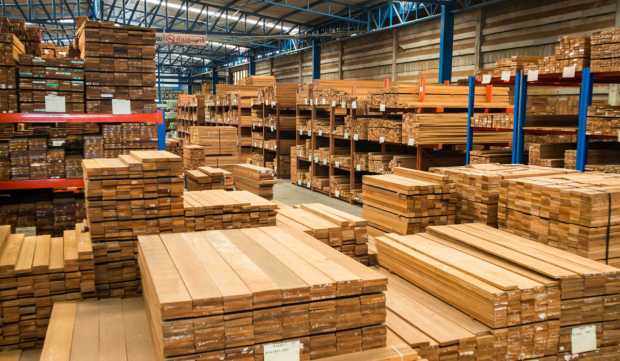With Roots in Commodity Trading, MaterialsXchange Moves Lumber Sales Digital

Early on, marketplace platforms experience what’s known as an ignition problem — a kind of chicken-and-egg dilemma where prime movers need to start adoption before everyone else signs on, too, realizing the dynamics that make platforms so efficient.
The digitization of retail commerce is now firmly rooted in platform dynamics — Amazon being a good example — but in B2B, things move at a slower pace, often depending on who controls the legacy processes that dominated before digital platforms became ubiquitous.
It’s a drama playing out now in the lumber industry — estimated globally at $1 trillion, with the U.S. accounting for roughly $300 billion of that figure. Avid proponents of platform efficiencies are trying to take the legacy out of the massive lumber vertical, awaiting that ignition moment.
Conversing with PYMNTS’ Karen Webster, Mike Wisnefski CEO at online construction materials marketplace MaterialsXchange, discussed the company’s new agreement with commodities fintech Mickey and a massive opportunity to digitize this space.
Wisnefski started as a trader on the Chicago Mercantile Exchange, and soon figured out that exchanges were controlled by suppliers, leaving little room to move on price or innovate. As markets went digital, he wanted to bring algorithmic speed and accuracy to the lumber vertical.
“That’s how the whole idea got started,” he told Webster. “What was discovered was that the physically traded commodity markets are not pure exchanges. It’s like a hybrid between eCommerce and an exchange. What an exchange does really well is allow for price discovery.”
That’s good for the end user, but not for the suppliers controlling exchanges that benefit from pricing opacity, so MaterialsXchange was formed to change the balance of power.
As with so many industries, Wisnefski said COVID-19 revealed these imbalances and opened the door for digital disruption.
“The status quo had a hard time wrapping their heads around it. They were getting whipsawed,” he said. “So at a time when their customers wanted longer term pricing and more secure prices, they did the reverse, and they shortened the shipment times, they gave them less secure pricing, they had less availability.”
Read: Tech Startup Mickey Merges With B2B Marketplace MaterialsXchange to Form Lumber Exchange
Sawmill Economics Meet the Digital Shift
That change in polarity is a turning point for a massive industry that he said is still in many ways stuck in the 1800s in the U.S., while it has modernized considerably in regions like Europe.
It’s also a way of improving price and value on a valuable commodity that for ages has been controlled — and even manipulated — by large legacy players with nothing to gain from a marketplace model that MaterialsXchange and its Mickey pact address.
“Selling is an expense and an inconvenience. If you look at a sawmill, that piece of lumber that comes out the end of the mill it is at its highest value right there at the end of the mill,” he said. “From that point on all they do is add expenses.”
Better to connect the end of the sawmill said. The platform facilitates the buying and selling, and they’ve outsourced payments processing to the Balance B2B solution.
With payments handled, he said “the challenge for us is verifying exactly what shipped. We’re working on that right now. What we’re finding is there are other more digital companies, or companies that have angled towards being more digital, that work really well in that process.”
He illustrated by giving an all-too-common example of a truck pulling into a port and loading what’s supposed to be, say, $25,000 worth of material, and only a paper bill of lading as proof.
This is where he sees “a lot of opportunity to do it digitally and do it right.”
See also: B2B BNPL Reduces Friction Between Suppliers and Buyers
Solving the ‘Ignition Problem’
It’s a complicated set of problems, and this very legacy business is still dogged by a certain level of chicanery that open digital marketplaces can help solve with the right data, and that first set of large users to solve the ignition problem.
Time was the pricing volatility that could be written into what end users like contractors charge. But when lumber prices soared 300% during the pandemic, it revealed a somewhat rigged system.
“Ironically there’s other examples we could look to in the international market where they’re using third party letter of credit and there’s really a chain of custody,” he said. “They’ve solved for it because there’s shenanigans like that. That’s something that we’re looking into moving forward in where we will become that trusted third party in the middle.”
Right now, MaterialsXchange has some marketplace competition from firms like Yesler, but no one until now has created a transparent digital B2B marketplace like Wisnefski is building.
Calling legacy enterprise systems “islands” in the process that are disconnected, he said “one of our big roles here is you have a supplier that has an enterprise system and a buyer that has an enterprise system, but you need a kind of a clearing house in the middle that can connect up.”
Still missing — and part of the opportunity he’s tapping into — is connecting these “islands” through digital logistics. “It’s still that piece of paper that gets signed at the gate when the truck rolls through. So, every day that we move forward, and new technologies come out or new software comes out, the gaps between the islands get smaller and smaller.”
This is where digital marketplaces become the great equalizer, which is the position MaterialsXchange and its Mickey agreement want to fill for this trillion-dollar vertical.